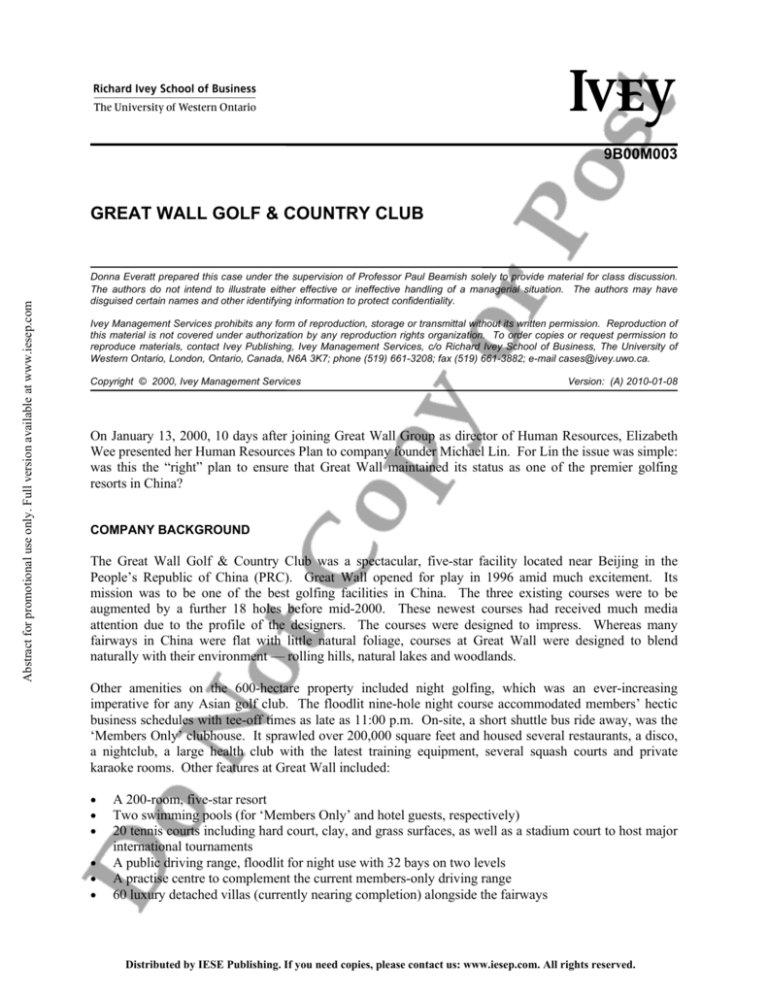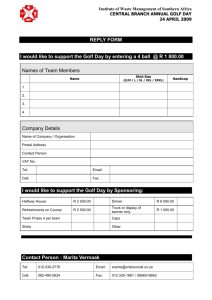
S
w
9B00M003
Abstract for promotional use only. Full version available at www.iesep.com
GREAT WALL GOLF & COUNTRY CLUB
Donna Everatt prepared this case under the supervision of Professor Paul Beamish solely to provide material for class discussion.
The authors do not intend to illustrate either effective or ineffective handling of a managerial situation. The authors may have
disguised certain names and other identifying information to protect confidentiality.
Ivey Management Services prohibits any form of reproduction, storage or transmittal without its written permission. Reproduction of
this material is not covered under authorization by any reproduction rights organization. To order copies or request permission to
reproduce materials, contact Ivey Publishing, Ivey Management Services, c/o Richard Ivey School of Business, The University of
Western Ontario, London, Ontario, Canada, N6A 3K7; phone (519) 661-3208; fax (519) 661-3882; e-mail cases@ivey.uwo.ca.
Copyright © 2000, Ivey Management Services
Version: (A) 2010-01-08
On January 13, 2000, 10 days after joining Great Wall Group as director of Human Resources, Elizabeth
Wee presented her Human Resources Plan to company founder Michael Lin. For Lin the issue was simple:
was this the “right” plan to ensure that Great Wall maintained its status as one of the premier golfing
resorts in China?
COMPANY BACKGROUND
The Great Wall Golf & Country Club was a spectacular, five-star facility located near Beijing in the
People’s Republic of China (PRC). Great Wall opened for play in 1996 amid much excitement. Its
mission was to be one of the best golfing facilities in China. The three existing courses were to be
augmented by a further 18 holes before mid-2000. These newest courses had received much media
attention due to the profile of the designers. The courses were designed to impress. Whereas many
fairways in China were flat with little natural foliage, courses at Great Wall were designed to blend
naturally with their environment — rolling hills, natural lakes and woodlands.
Other amenities on the 600-hectare property included night golfing, which was an ever-increasing
imperative for any Asian golf club. The floodlit nine-hole night course accommodated members’ hectic
business schedules with tee-off times as late as 11:00 p.m. On-site, a short shuttle bus ride away, was the
‘Members Only’ clubhouse. It sprawled over 200,000 square feet and housed several restaurants, a disco,
a nightclub, a large health club with the latest training equipment, several squash courts and private
karaoke rooms. Other features at Great Wall included:
•
•
•
•
•
•
A 200-room, five-star resort
Two swimming pools (for ‘Members Only’ and hotel guests, respectively)
20 tennis courts including hard court, clay, and grass surfaces, as well as a stadium court to host major
international tournaments
A public driving range, floodlit for night use with 32 bays on two levels
A practise centre to complement the current members-only driving range
60 luxury detached villas (currently nearing completion) alongside the fairways
Distributed by IESE Publishing. If you need copies, please contact us: www.iesep.com. All rights reserved.
Page 2
•
•
9B00M003
Children’s play areas, complete with a large variety of equipment
Transportation for the one-hour drive on modern highways to/from central Beijing by luxury coach,
available at a modest fee
Abstract for promotional use only. Full version available at www.iesep.com
A Gold membership at Great Wall sold for US$80,000 for either an individual or corporation, each with
one nominee. As with many other golf clubs in Asia, memberships were transferable which meant they
were bought and sold on a secondary market. Also, members could sponsor up to two other people,
allowing them to join at a discount.
The Great Wall Group, with successful ventures in residential development and real estate, was established
in 1993 by its chairman and the owner of the Great Wall Golf & Country Club, Michael Lin. The Great
Wall Group had earlier invested in a golf course in California, and more recently, had developed a golf
resort in Taiwan. With its nearly 2,000 employees, the Great Wall facility in China was regarded as one of
the most prestigious mainland courses, and represented an investment to date of close to US$400 million.
Development of the golf resort industry in China was chosen for several strategic reasons. As recently as
1995, the business elite had few choices if they were looking for a golf club membership — corporate
memberships at the other courses near Beijing were sold out and private members faced waiting lists.
Moreover, corporate memberships had been sold for large premiums.
Another impetus for the development of a golf resort was the fact that it had the potential to attract
investors to the residential community and commercial properties being developed. Planned development
included the completion of the 60 luxury villas (the majority of which had been pre-sold), followed by
residential highrises, luxury housing, shopping malls, commercial buildings, sports complexes,
entertainment centres, restaurants and other hotels which were to be developed within the next 10 years.
This vision was on a scale seldom seen to this point in Asia — the Great Wall complex was to integrate
sports and holiday facilities with business and convention functions in one modern community.
SENIOR MANAGEMENT
The 10-member executive committee was chaired by Michael Lin, a Singapore-born American citizen.
The national press and those throughout his Club viewed him as a distinguished visionary who
commanded a great deal of respect. Several members of the Lin family sat on the executive committee,
including Lin’s two sons, David (25) and Roland (27). All were well educated and dedicated to ensuring
the smooth operation of the Club and the satisfaction of Great Wall’s members and guests.
The most recent addition to the executive committee was Elizabeth Wee, a Human Resources Professional,
born and raised in Malaysia. She was a veteran of the hospitality industry, with 25 years’ experience.
After graduating with a bachelor’s degree in the hospitality industry from a well known college in the U.S.,
she had worked for major hotels in Central Europe, Asia and North America for 20 years. She had also
worked with several high-end hotel chains in China, where she had been an area director of Human
Resources in charge of six hotels in Shanghai for five years prior to joining Great Wall.
The overarching mandate of the executive committee was setting the strategic direction for Great Wall, its
development, and broad sales and marketing issues. However, as with most rapidly growing firms,
members of the executive committee devoted considerable time to the operational concerns of the facility.
According to David Lin, one of the most important managerial issues at Great Wall was creating a fertile
ground for the smooth transition of operating control to senior staff, thus allowing members of the
Distributed by IESE Publishing. If you need copies, please contact us: www.iesep.com. All rights reserved.
Page 3
9B00M003
Abstract for promotional use only. Full version available at www.iesep.com
executive committee to turn their attention more fully to Great Wall’s long-term opportunities. Great
Wall’s overall emphasis was on profit, innovation and quality, to be market-driven, to focus on
professional development (including staff development) and to support growth. Their vision was to be
acknowledged and accredited within the international community as world class, and among the best in
Asia.
For the first two years of operation, the vast majority of senior managers were of Chinese origin, recruited
from both Singapore’s and Hong Kong’s hospitality industry. Few, however, had experience in the golf
industry. Great Wall’s senior management felt that the Singapore Chinese were valuable not only for their
hospitality industry experience but for their ability to speak Mandarin, the language spoken by about 90 per
cent of Great Wall’s members. Hiring such a high percentage of Singapore Chinese managers differed
from the strategy of other service businesses in Asia, many of whom brought in offshore expatriates with
extensive hospitality experience in their home country — but not necessarily local market language skills
— to establish an operational base at inception. For example, one prestigious Asian hotel chain typically
installed up to 100 expatriates in management positions for a minimum of one year for the launch of a new
hotel. In contrast, the (larger) Great Wall Group had 60 expatriates among its 70-person management
group, including 30 from Hong Kong, 30 from Singapore and 10 from overseas.
A Singapore or Hong Kong Chinese manager would also be perceived as an expatriate by the mainland
Chinese, given their disparate backgrounds, ideology and, in some cases, language. Moreover, the
Singaporean or SAR (Hong Kong) Chinese generally received much higher salaries and positions than
mainland Chinese employees.
THE HISTORY AND FUTURE OF GOLF IN CHINA
The open-door policies of Deng Xiaoping in 1979 saw golf, previously banned in China and described as
“a prime example of Western decadence,” reintroduced into the country. This was done primarily with a
view to bringing in foreign exchange. However, when Jack Nicklaus was asked 12 years ago to design a
course in Beijing, he declined, saying, “I was not interested — I mean, who the hell was ever gonna play
it?” While, in 2000, golf in China was still far from being a sport for the masses, the golfing boom that had
swept the region over the past decade had finally and firmly established a foothold among the indigenous
population. Seen as a way to increase their professional status and social standing, prominent political and
business figures, previously not familiar with the sport, sought memberships at prestigious clubs when they
saw that the reputations of their colleagues increased through membership. Prestigious golf club
memberships (where ‘Members Only’ signs were an essential part of the decor) were an important means
of developing both business and social contacts. The sport had seen significant growth. The market in
China was estimated to be over 100,000, plus expatriates.
To meet demand, China’s rate of golf course development outpaced many other countries in Asia and lush
golf courses were steadily replacing once placid paddy fields and farmland. There had been phenomenal
growth in golf course development. Some observers believed that the proliferation of private clubs in
China had been too rapid, outpacing market growth.
According to some analysts, the market was oversaturated and many more mainland Chinese would need
to take up the sport to sustain the rate of golf course development. With green fees averaging US$150 per
round, golf was still very much an elite sport in China. However, China had seen a rise in the middle class
over the last decade and an increasing number of mainland Chinese businesspeople believed that golf
suited their corporate image and desire for status. Currently, there was a strong trend in China for bankers
Distributed by IESE Publishing. If you need copies, please contact us: www.iesep.com. All rights reserved.
Page 4
9B00M003
to play golf. Moreover, estimates were that it would take no more than 10 years before golf became the
important networking tool it was elsewhere in the world. Though some clubs were currently struggling, it
was generally felt that with the continuing growth in Chinese players, most clubs in China that were well
managed, with a good location and providing excellent service, would survive.
Abstract for promotional use only. Full version available at www.iesep.com
Whereas US$150,000 golf club memberships could be sold over the phone sight-unseen in previous years,
membership drives had become more aggressive over the last several years. Lower-priced memberships
were offered to penetrate other segments of the market. The Chinese market was being developed because
the ill effects of the Asian financial crisis of the late 1990s had not been felt there as intensely.
The predominant source of new members was the guests of current members who had visited the club, or
those who had been referred by a member. Thus exceeding the customer service expectations of both
members and their guests was seen not only as a prime consideration provided to members, but also as a
critical marketing tool.
ORGANIZATIONAL STRUCTURE
In order to enhance operating efficiency and develop specific skill sets among such a vast number of
employees, Great Wall organized itself functionally. Departmental activities revolved around well defined
areas of concentration, such as Food & Beverage (‘F&B’), Security, Golf Course Management and Golf
Course Maintenance and Development (see Exhibit 1).
RECRUITING
When the first group of 2,000 employees was recruited to meet the demands of one of China’s largest
golfing facilities, the ads placed in the newspaper to draw applicants were well received. As with many
projects in China, the demand far exceeded the supply of jobs available and sifting through the applications
was the challenge. Candidates were chosen based on their experience and their interpersonal skills,
assessed during a brief interview conducted by the Human Resources department.
Turnover among the rank and file at Great Wall was below the four per cent a month level found in
comparable service sector facilities in the area, but still somewhat above the desired level. Staffing for
many businesses was a challenge, due to the migrant nature of the workforce. Migrants from all over
China had flooded in, attracted by jobs with above average salaries. No matter how good the job, many of
the workers in any business were inclined to return to their own city or province once they had
accumulated sufficient money. Thus either for financial reasons or a desire to be reunited with family
members, many workers would leave after 18 to 24 months. At Great Wall, the ability to retain staff who
had long-standing relationships with members was considered a key competitive advantage. Golf Club
Reception, Food & Beverage, Caddies and Membership Services were departments where long-term
service would go a long way toward increasing customer service standards and advancing Great Wall
toward its strategic objective of providing very high quality service.
TRAINING & DEVELOPMENT
Great Wall’s goal was to provide personalized, high quality service to every one of its 2,000 members.
The high-ranking, successful Chinese businesspeople and government officials, their spouses and guests
Distributed by IESE Publishing. If you need copies, please contact us: www.iesep.com. All rights reserved.






